
In the Quechua, Aymara, and Inca mythologies, Supay was both the god of death and ruler of the Ukhu Pacha, the Incan underworld, as well as a race of demons. Supay is associated with miners' rituals.

Oruro or Uru Uru is a city in Bolivia with a population of 264,683, about halfway between La Paz and Sucre in the Altiplano, approximately 3,709 meters (12,169 ft) above sea level.
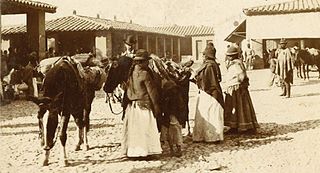
The Aymara or Aimara, people are an indigenous people in the Andes and Altiplano regions of South America. About 2.3 million live in northwest Argentina, Bolivia, Chile, and Peru. Their ancestors lived in the region for many centuries before becoming a subject people of the Inca Empire in the late 15th or early 16th century, and later during the Spanish conquest of Peru in the 16th century. With the Spanish American wars of independence (1810–1825), the Aymaras became subjects of the new nations of Bolivia and Peru. After the War of the Pacific (1879–1883), Chile annexed territory with the Aymara population.
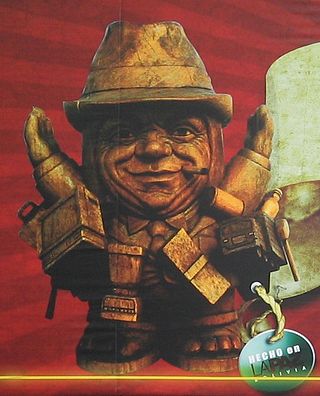
The Ekeko is the Tiwanakan god of abundance and prosperity in the mythology and folklore of the people from the Bolivian Altiplano. Its chief importance in popular culture is as the main figure of the annual Alasitas fair, a cultural event that happens every January 24 in La Paz, Bolivia. The Ekeko is a traditional god of luck and prosperity popular in the western region of Bolivia. In Peru the main festival is celebrated on May 3 of every year in the city of Puno, on the Machallata hill.

Andean music is a group of styles of music from the Andes region in South America.
Peruvian music is an amalgamation of sounds and styles drawing on Peru's Andean, Spanish, and African roots. Andean influences can perhaps be best heard in wind instruments and the shape of the melodies, while the African influences can be heard in the rhythm and percussion instruments, and European influences can be heard in the harmonies and stringed instruments. Pre-Columbian Andean music was played on drums and string instruments, like the European pipe and tabor tradition. Andean tritonic and pentatonic scales were elaborated during the colonial period into hexatonic, and in some cases, diatonic scales.
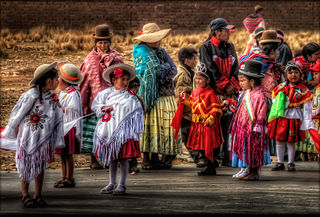
Bolivia is a country in South America, bordered by Brazil to the north and east, Paraguay and Argentina to the south, Chile to the west, and Peru to the west.

The Altiplano, Collao or Andean Plateau, in west-central South America, is the most extensive high plateau on Earth outside Tibet. The plateau is located at the latitude of the widest part of the north–south-trending Andes. The bulk of the Altiplano lies in Bolivia, but its northern parts lie in Peru, and its southwestern fringes lie in Chile.

Lake Poopó was a large saline lake in a shallow depression in the Altiplano Mountains in Oruro Department, Bolivia, at an altitude of approximately 3,700 m (12,100 ft). Due to the lake's length and width, it made up the eastern half of Oruro, known as a mining region in southwest Bolivia. The permanent part of the lake body covered approximately 1,000 square kilometres (390 sq mi) and it was the second-largest lake in the country. The lake received most of its water from the Desaguadero River, which flows from Lake Titicaca at the north end of the Altiplano. Since the lake lacked any major outlet and had a mean depth of less than 3 m (10 ft), the surface area differed greatly seasonally.
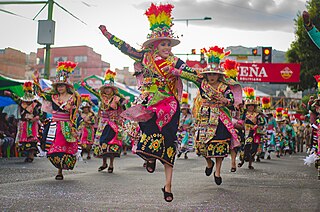
Tinku, a Bolivian Aymara tradition, began as a form of ritualistic combat. In the Quechua language, it means "meeting-encounter". During this ritual, men and women from different communities will meet and begin the festivities by dancing. The women will then form circles and begin chanting while the men proceed to fight each other; eventually the women will join in the fighting as well. Large tinkus are held in Potosí during the first few weeks of May.

Huayno is a genre of popular Andean music and dance. It is especially common in Peru, Western Bolivia, Northern Argentina and Northern Chile, and is practiced by a variety of ethnic groups, especially the Quechua people. The history of Huayno dates back to colonial Peru as a combination of traditional rural folk music and popular urban dance music. High-pitched vocals are accompanied by a variety of instruments, including quena (flute), harp, siku (panpipe), accordion, saxophone, charango, lute, violin, guitar, and mandolin. Some elements of huayno originate in the music of the pre-Columbian Andes, especially on the territory of the former Inca Empire. Huayno utilizes a distinctive rhythm in which the first beat is stressed and followed by two short beats.

Uyuni is a city in the southwest of Bolivia.

The Carnival of Oruro is a religious and cultural festival in Oruro, Bolivia. It has been celebrated since the 18th century in the Peruvian virreynato. Originally an indigenous festival, the celebration later was transformed to incorporate a Christian ritual around the Virgin of Socavón. The carnival is one of UNESCO's Masterpieces of the Oral and Intangible Heritage of Humanity.

The Danza de las tijeras is an original dance of Chanka origin from the south of the Andes, in Peru. The dance consists of two or more dancers, followed by their respective orchestras of a violin and a harp. The dancers dance in turns, doing explicit moves and challenging steps, such as dancing with just one foot.

The Kullawada, kullahuada, cullaguada or kullawa is a dance practiced in Bolivia and Peru and there is controversy about the origin of the dance between Bolivia and Peru. The name of the dance derives from the word kullawa, in reference to its dancers. In Bolivia, kullawada is danced mainly in the Carnaval de Oruro, the Fiesta del Gran Poder, the Festividad de la Virgen de Urkupiña and the Festividad de Chutillos. In Peru the dance is represented in the Fiesta de la Candelaria.
The Morenada is an Andean folk dance whose origins are still under debate. This dance is practiced mainly in Bolivia as well as in Peru and in recent years with Bolivian immigration in Chile, Argentina and other countries.

The Son de los Diablos is an Afro-Peruvian dance that developed as a mixture between African, Spanish, and Amerindian rhythms. Nicomedes Santa Cruz explains that, despite popular opinion, the Son de los Diablos has no links with African rituals or with the Andean Morenada, but rather it has a very slight similarity with the Diabladas of Oruro (Bolivia).

Pachamama is a goddess revered by the indigenous peoples of the Andes. In Inca mythology she is an "Earth Mother" type goddess, and a fertility goddess who presides over planting and harvesting, embodies the mountains, and causes earthquakes. She is also an ever-present and independent deity who has her own creative power to sustain life on this earth. Her shrines are hallowed rocks, or the boles of legendary trees, and her artists envision her as an adult female bearing harvests of potatoes or coca leaves. The four cosmological Quechua principles – Water, Earth, Sun, and Moon – claim Pachamama as their prime origin. Priests sacrifice offerings of llamas, cuy, and elaborate, miniature, burned garments to her. Pachamama is the mother of Inti the sun god, and Mama Killa the moon goddess. Mama Killa is said to be the wife of Inti.

Bolivians are people identified with the country of Bolivia. This connection may be residential, legal, historical or cultural. For most Bolivians, several of these connections exist and are collectively the source of their being Bolivian.
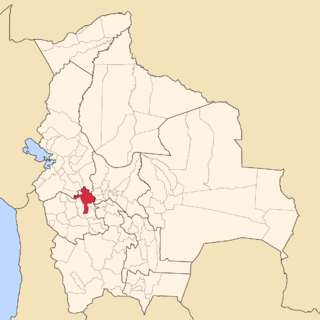
The Wankarani culture was a formative stage culture that existed from approximately 1500 BCE to 400 CE on the altiplano highlands of Bolivia's Oruro Department to the north and northeast of Lake Poopo. It is the earliest known sedentary culture in Bolivia, as after circa 1200 BCE camelid hunters of the altiplano became camelid herders and sedentary lifestyle developed. The Wankarani culture was little researched before 1970, when Carlos Ponce Sanginés defined all the mound sites in the area as belonging to one culture that predated Tiwanaku and was contemporary with the Chiripa culture.























